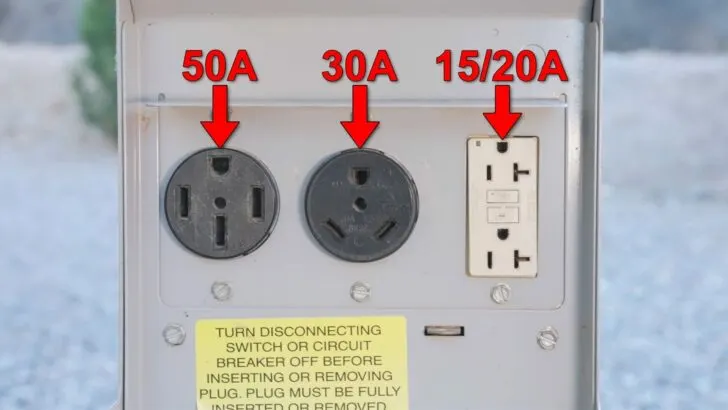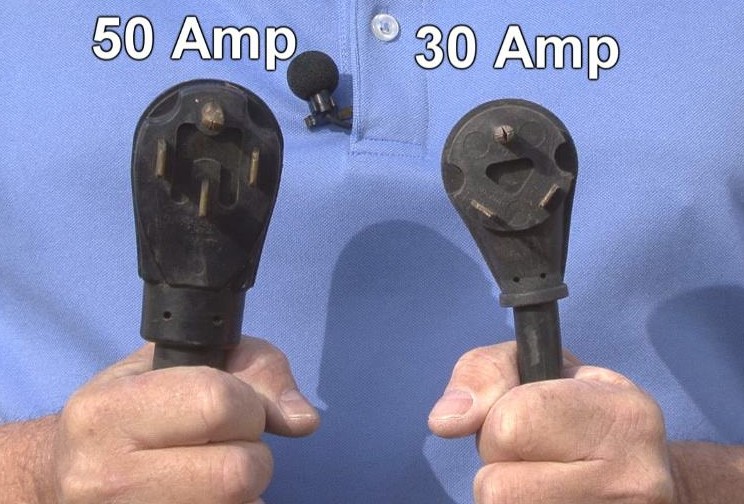Your home on wheels, your RV provides home-like comfort when traveling and camping. While your home has a stable supply of electricity, your RV does not. You are responsible for bringing electricity to your RV. Solar panels, generators, and electrical outlets in campgrounds and trailer parks can do this.
An RV plug is a power cord that connects to a power source on one end and has a plug on the other that hooks up your RV to the power source.
Typically, your RV outlet will have a 30 amp or 50 amp rating. This basically means that the maximum amount of electricity your RV can handle before the breaker trips is 30 or 50 amps. This can happen to you at home if you have too many appliances plugged in and running together.
Check out what wiring a 50 amp plug and a 30 amp plug look like.
Differences Between 30 Amp Plug and 50 Amp Plug

Your RV’s electrical system will malfunction if you use the incorrect plug because it will either deliver too much or not enough electrical current. The incorrect connection will trip a breaker or activate a surge protector as a safety measure. It is, therefore, important to know the difference between a 30 amp plug and a 50 amp plug.
1. Current Capacity
The term 30 amp means that you can use a maximum of 30 amperes of current from a 30 amp plug. The maximum power you can draw from this plug is 3600 watts because its hot wire delivers 120 volts of alternating current. If you draw over 30A, the breaker will trip.
A 50 amp plug delivers 50 amp of current to your RV. It runs at 240 volts with 120 volts in each hot wire. You can, therefore, draw 12000 watts from this plug. If you draw more than 50 amps, the breaker will trip.
2. Usage
30 amp plugs are usually used in RVs that have a roof air conditioner, a microwave, a refrigerator, a TV, and a few outlets that are made for 120-volt appliances.
A 50 amp plug is typically used for larger appliances and high-demand electrical systems. Common applications include large RVs, electric ranges, and some industrial equipment, and it can also support multiple appliances simultaneously.
3. Structure
The 50 amp plug is bigger than the 30 amp plug, which might help you differentiate between the two. However, the easiest way is to look at the number of pins on the plugs.
A 30 amp plug typically has three prongs where two are hot pins, and one is a ground pin. The hot pins are usually at a 120-volt potential difference or 240-volt potential difference from each other.
A 50 amp plug has four prongs where two are hot pins, one is a neutral pin, and one is a ground pin. The neutral wire is included to provide a complete circuit and is important for safety and code compliance.
Paying Special Attention to The Pins
You should pay special attention to the pins of the 30 amp plug because a 15 or 20 amp plug also has three pins. A 15 or 20-amp plug has two flat pins and one U-shaped pin, whereas the pins on the 30-amp plug have a circular look to them. The two flat pins are at an angle, and the third pin makes a circle instead of a U.
It is very important to match the electrical supply and the plug correctly with the appliance or device you use. Mismatching can lead to electrical issues, overheating, and potential safety hazards. You also need to adhere to the local electrical rules and regulations set by the authorities when installing or using the plugs. If you are unsure which plug would match your needs, consult a professional electrician. It is better to be cautious than sorry.
Know Your Power Adapters
Even though the 30 amp plug and the 50 amp plug are different, it is possible to connect a 30 amp plug to a 50 amp hookup. You would need the correct, but it would not change or increase the power you can draw. If your RV needs 50 amps to power all the lights, electronics, and two air conditioners, but you are connected to a 30 amp hookup using an adapter, you can only draw 30 amps before the breaker trips.
Importance of Surge Protector
No matter what type of plug you choose, your RV must have a surge protector. The device and your RV plug are connected, and the device then connects to the power source. If lightning strikes or there is a problem with the power source, the protection will stop surges. The electrical system of your RV or any linked appliance inside the RV could get damaged by a surge.
Conclusion
You can continue to meet your electronic needs whether you choose to go with the 30 amp system or the 50 amp system. For people who do not need a lot of power, a 30-amp system is ideal. It is perfect for smaller RVs that only include the most basic comforts. A 50 amp system is designed for bigger RVs that can accommodate more people, appliances, or both.
You should figure out what your realistic electrical consumption is and then choose the appropriate system. It really comes down to your realistic electrical consumption as both are reliable and easily accessible in campgrounds.

